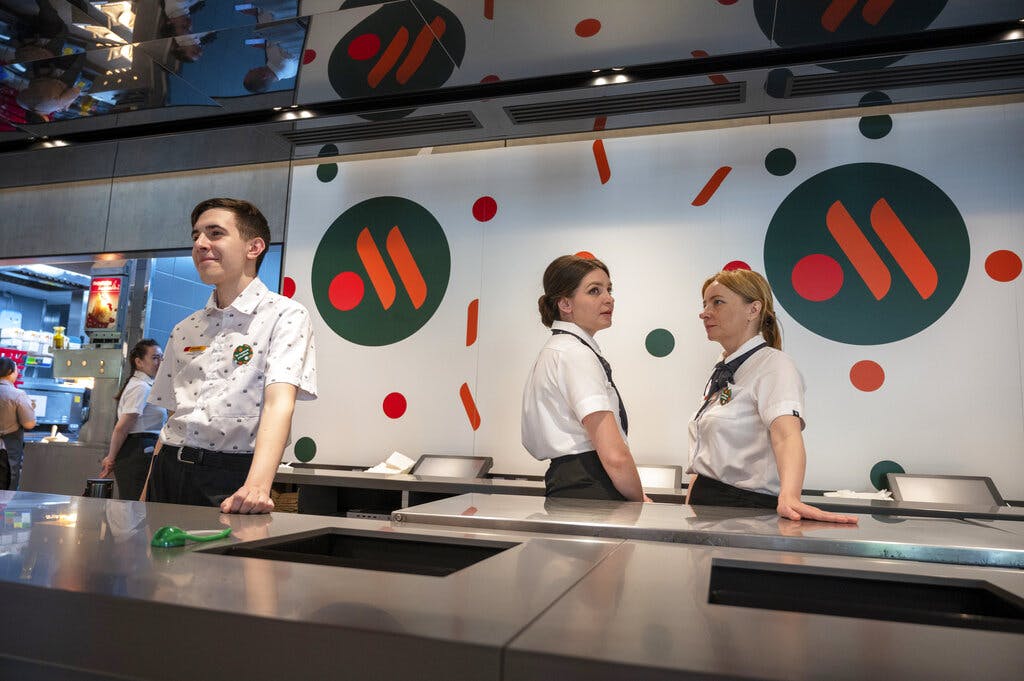Former Moscow McDonald’s Opens After Iffy Makeover; Russian Cars in Reverse
The crowd at the Pushkin Square outlet, however sizable and lively, was no match for the turnout for the McDonald’s opening in 1990, when people lined up to wait for hours.

While a branch of the Russian-owned successor to McDonald’s opened to considerable local enthusiasm in Moscow this week, it represented a nail in the coffin of the late Soviet notion of glasnost, or openness — and a sign on the door of the global village that thanks to Vladimir Putin’s invasion of Ukraine, Russia is no longer really a part of it.
Three months after McDonald’s suspended operations in Russia, hundreds of people streamed into its famous former outlet on Moscow’s Pushkin Square as the restaurant formally reopened Sunday under a Russian owner and a new name.
It was in March that McDonald’s halted operations of its company-run restaurants in Russia. Although some run by franchisees stayed open, the action by the multinational fast-food chain was among the most visible responses by foreign companies to Russia sending troops into Ukraine.
Two months later, McDonald’s decided to leave Russia altogether and sold its 850 restaurants to Alexander Govor, who held licenses for 25 franchises in Siberia. Mr. Govor is moving fast to reopen the shuttered outlets. It wasn’t until a couple of hours before the Pushkin Square restaurant opened that the Russian chain’s new name was announced: Vkusno-i Tochka, meaning Tasty-and-that’s-it.
The logo is different, but still evokes the golden arches: a circle and two oblongs — representing a beef patty and french fries — configured into a stylized M. Fifteen of the former McDonald’s were set to reopen in Moscow on Sunday. The chain’s general director, Oleg Paroev, said he aims to have 200 open by the end of the month.
The crowd at the Pushkin Square outlet, however sizable and lively, was no match for the turnout for the McDonald’s opening in 1990, when people lined up to wait for hours. At that time, McDonald’s had psychological and political resonance beyond hamburgers.
The opening was the first taste most Muscovites had of Western consumerism and service efficiency, as well as a sign the Soviet Union was slowly dropping its guard and allowing in foreign culture.
That earlier symbolism echoed through Sunday’s reopening with a note of nostalgia. “This is a historic place — the flagship of McDonald’s,” Mr. Govor told reporters. “I’m sure it will be the flagship for us.”
Inside, the restaurant resembled a fraternal twin of its former self. There were touchscreens for placing orders and counter workers wearing familiar polo-shirt uniforms.
“We’re sure that our customers won’t notice a difference between us,” Mr. Paroev said.
That may or may not be the case, but what is clear is that Russia’s descent into autarky isn’t stopping with hamburgers. Russian automaker Lada has just launched a new “sanction-proof” car that has been derided as a flashback to the Soviet Union, as it fails to offer airbags, an anti-lock braking system, modern seat belts, or satellite navigation, the Telegraph reported.
The Lada Granta Classic 2022 was designed to use components only from Russia and its allies, but that means its anti-emissions systems fall well short of current standards, with Russian car journalists reporting that the new car will only meet European pollution standards imposed in 1996.
Produced by state-owned car manufacturer Avtovaz, the Lada Granta Classic 2022 is an attempt to kickstart production after Western sanctions flattened the Russian car sector, forcing the closure of the main production site in the city of Tolyatti at the beginning of March, according to the Telegraph report.
Western sanctions on Russia since the Kremlin’s invasion of Ukraine have resulted in a run on imported car parts typically used in Russia’s automotive industry. The new all-Russian Lada will reportedly retail for 675,900 rubles, or about $11,500, making it the cheapest car available on the Russian market. Reports indicate a steering wheel is included.
